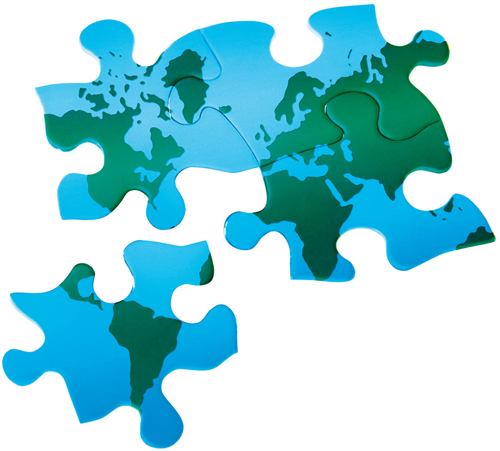Going Global
At one time, South America’s natural resources provided its primary economic link to other global regions. But now its manufacturing base is strengthening, its consumer market is growing, and its industries are diversifying. South America’s role on the world stage has moved far beyond the commodities exports of earlier years.

North America
South America’s largest trading partner is the United States. Proposed economic integration through a Free Trade Alliance of the Americas has been given up due to waning US influence in the region. However, the US is still a large consumer of South American agricultural and mineral products, and a major source of foreign direct investment. Of late, US companies are not just buying the region’s agricultural produce but are buying the land also so that they own production capacity.
Europe
Colonization by Spain and Portugal saw immigrants from Europe settling in South America. As their descendents have built successful businesses in the region, many look to their family homelands for global partners. Exports, subsidiaries, and joint ventures are found across the Atlantic, with movement both ways. Trade with Europe provides a large market for export, high-quality goods for import, and business partners who are well funded and efficient.
Latin America
Latin America is made up of the western hemisphere countries colonized by Spain and Portugal. These countries are bound by historical and cultural similarities, and includes Mexico, Central America, many Caribbean nations, and the South American nations. Countries in this region are increasing trade with one another. Companies are exporting and partnering throughout the region in a wide range of industries including aircraft design, cosmetics, beverage, and retail.
The rest of the world
Russia and China serve as a counterpoint to the influence of the US in the region. When political differences made trade with the US untenable, countries like Venezuela turned to Russia. Russian influence is strong when its economy is strong, but China is a new alternative. China is pouring money into South American economies to create infrastructure and to secure supplies of resources like oil, iron ore, and soya for its fast-growing demands. The Middle East has ties to South America through immigration that led to both import and export. Slavery brought many Africans to South America, but the two regions do not share much economically—both regions look to wealthier partners for their business focus.
Brazilian company goes global
Natura launched its eco-friendly cosmetics lines in Brazil in 1969 and managed its international expansion from the familiar to the distant. The company expanded into Chile in 1982. After an unsuccessful stint in the US, the company moved into another South American neighbor, Bolivia. Natura spread still further, to Argentina, Mexico, Colombia, and Venezuela. In 2002, the company began retailing at Brazilian airports. Success in selling to tourists led to a shop in Paris, and then expansion to other parts of Europe and to Japan.
TIP
Take advantage of established diplomatic and business links to find your way into South America.
